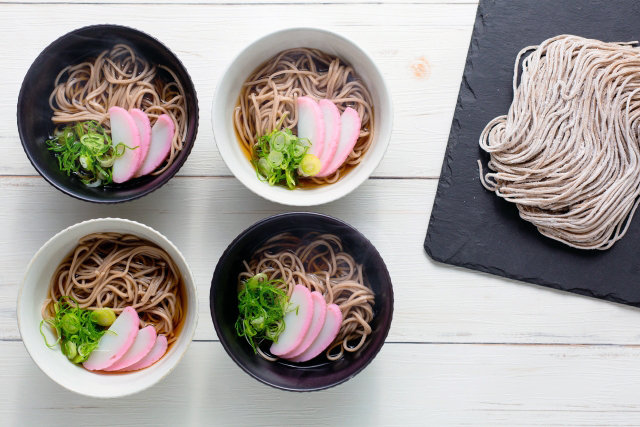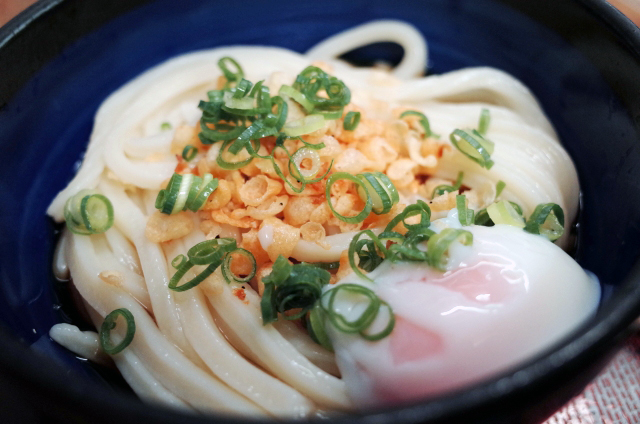Japanese soba and udon noodles are famous around the world but many travellers aren’t sure how to tell the difference. In this article, we’ll introduce you to Japanese noodles and explain the difference between soba and udon. Then, we’ll teach you how to make them and give you some tips on how to eat them.

What are soba noodles?
Soba noodles are long, thin noodles made from buckwheat flour. They look a lot like brown spaghetti! Soba has a firm, dense texture and a rich, nutty flavour. It’s a feature of many first-class Japanese restaurant menus and you can enjoy it all year round.
Because it’s made with buckwheat, soba has a range of health benefits. It’s been proven to lower blood sugar and cholesterol, reduce inflammation, and lower the risk of heart disease.

To make soba, just take buckwheat flour, add water and wheat flour, and knead into a thin dough. Then, slice the dough into long strips about 1-2mm wide and cook them in boiling water. For completely gluten-free noodles, you can make soba with 100% buckwheat flour. However, buckwheat flour is harder to work with on its own and will produce more fragile noodles.
What are udon noodles?
Udon noodles are made from wheat flour. They’re glossy white and thick, with a chewy, springy texture. Because udon noodles have such a mild flavour, they taste good with almost anything.
If you’re visiting Japan, remember to stop in at Kagawa Prefecture, the home of udon noodles. It’s famous for delicious sanuki udon and people come from all over Japan just to sample a bowl!

Like soba, udon noodles are easy to make. Just combine wheat flour and salt water and knead into dough. Then, slice the dough into long noodles and cook them in boiling water.
What is tsuyu?
Both soba and udon noodles are flavoured with tsuyu, a combination of soy sauce, mirin, and dashi stock made from kombu (dried seaweed) and bonito flakes. It may also include a range of other ingredients and flavours. You can find unique tastes in different regions throughout Japan.
There’s an udon or soba dish to suit all seasons and tastes.
How to eat cold soba/udon
The most common cold noodle dish is zaru soba/udon. Chilled noodles are served on a bamboo tray with a small bowl of tsuketsuyu (tsuyu dipping sauce) topped with shredded seaweed. Common toppings include chopped scallions, sesame seeds, grated ginger, grated daikon, and shredded nori. Simply mix the toppings of your choice into the dipping sauce and then dip the noodles. Once the noodles are thoroughly coated, they’re ready to eat!
When you’ve finished your meal, some Japanese restaurants will give you a small teapot filled with the water your noodles were boiled in. It’s customary to mix the water with your leftover dipping sauce and drink it.
Other popular cold soba/udon options include:
- Hiyakeke soba/udon: chilled noodles covered with cold dashi.
- Hiyashi bukkake soba/udon: chilled noodles covered with concentrated tsuyu.
- Soba/udon noodle salad: chilled noodles in a salad with lettuce, tomato, etc., covered with a small amount of tsuyu. For extra flavour, you can also top the salad with soy sauce and mayonnaise-seasoned tuna.
How to eat hot soba/udon
The simplest hot noodle dish is kake soba/udon. Freshly boiled noodles are covered with hot tsuyu and topped with chopped green onions. You should eat your kake soba/udon quickly, holding the bowl close to your mouth. Don’t forget to make a slurping sound to let the chef know you are enjoying your noodles!
There are many other ways to enjoy hot soba/udon noodles. Here’s a few for you to try:
- Kitsune udon/soba: noodles topped with aburaage (a thin sheet of fried tofu, flavoured with soy sauce and sugar).
- Tanuki udon/soba: noodles topped with tempura scraps.
- Tsukimi udon/soba: noodles topped with a raw egg.
- Kamaage udon/soba: noodles mixed with raw egg and soy sauce.
- Yaki udon/soba: stir-fried noodles with meat and vegetables.
- Chikara udon/soba: noodles topped with roasted mochi (rice cake).
- Sansai udon/soba: noodles topped with wild fern and enoki mushrooms.
- Kenchin udon/soba: noodles in a soup with stir-fried vegetables.
- Curry udon/soba: noodles in a spicy, curry-flavoured sauce.
The possibilities are endless: there’s always a new udon/soba flavour to enjoy!
Soba allergies
Buckwheat is usually healthy and delicious, but it can cause allergic reactions. If you’ve never eaten buckwheat before and your mouth or throat starts to feel uncomfortable, stop eating immediately and seek medical advice. A swollen mouth or throat, nausea, and abdominal pain may be signs of a life-threatening anaphylactic reaction. If you experience these symptoms, you should seek immediate medical attention.
— Article From BACK LANE












